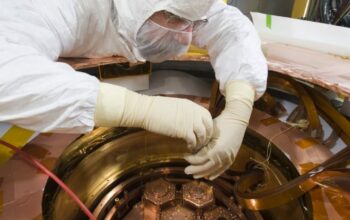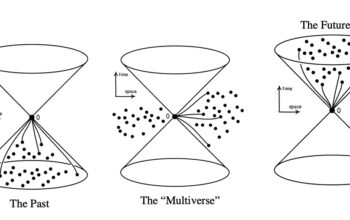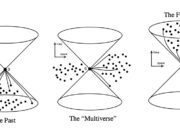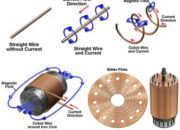The exploration of fundamental particles and the forces governing them has long captivated the scientific community, propelling humanity into realms that challenge both our understanding and imagination. In this arena, the potential advent of a new beacon—carbon-60—may illuminate the path toward groundbreaking advancements in particle physics. Carbon-60, a molecule consisting of 60 carbon atoms arranged in a unique spherical structure akin to a soccer ball, is more than a curious organic compound; it embodies the confluence of chemistry, nanotechnology, and theoretical physics.
To fully appreciate the significance of carbon-60 in the context of particle physics, one must first delve into the nature and characteristics of this remarkable molecule. Carbon-60, often referred to as “buckyball” due to its resemblance to the geodesic domes designed by architect Buckminster Fuller, exhibits remarkable structural stability and unique electronic properties. Its ability to endure extreme conditions while maintaining integrity positions it as a formidable candidate for various applications, including energy storage, medicine, and, most pertinently, particle physics.
The quest to explore the subatomic realm hinges upon the capability to generate and manipulate high-energy particles. Current particle accelerators, a hallmark of modern physics, are colossal infrastructures that consume vast amounts of energy and resources. They rely on traditional materials and technologies that face inherent limitations in terms of efficiency and scalability. In contrast, the incorporation of carbon-60 into particle accelerator designs could herald a new paradigm, optimizing particle generation and interaction processes while minimizing energy expenditure.
Imagine a particle accelerator built upon the foundations of carbon-60. Utilizing the unique properties of this molecule, scientists could develop advanced superconductors that operate at higher temperatures, reducing the cost and complexity of maintaining ultra-low-temperature environments required by conventional superconductors. This thermodynamic efficiency would parlay into the capacity to generate higher particle collision energies, thereby allowing physicists to probe deeper into the fundamental constituents of matter and the forces that govern their interactions.
Moreover, the extraordinary electron affinity of carbon-60 could be harnessed to create innovative detector technologies. By embedding carbon-60 derivatives in detector materials, researchers could amplify signal detection while concurrently improving the resolution of measurements. Enhanced detection capabilities would empower the exploration of elusive particles such as dark matter candidates, neutrinos, and other phenomena that remain shrouded in mystery in contemporary physics.
Additionally, one must consider the unprecedented versatility inherent in carbon-based materials. The development of hybrid systems, wherein carbon-60 is integrated with other advanced compounds, could yield composite materials displaying superlative electrical, thermal, and mechanical properties. Such composite materials could facilitate the construction of more energy-efficient and compact accelerators and detectors.
Carbon-60’s potential role as a component in nanoscale applications also merits discussion. Nanoscale technology plays an increasingly pivotal role in experimental particle physics, enabling the fabrication of devices and materials with unique properties that differ dramatically from their bulk counterparts. With its robust structure, carbon-60 could serve as a building block for quantum dots and other nanoscale components, allowing physicists to manipulate particles with unprecedented precision.
The synthesis of carbon-60, and its derivatives, can be achieved via various methods, including laser ablation, arc discharge, and chemical vapor deposition. As techniques for producing carbon-60 become refined and more economically viable, the integration of this molecule within particle physics research could become a widespread reality. This democratization of access to carbon-60 materials encapsulates the essence of scientific progress—making once unattainable technologies feasible for a broader spectrum of researchers within the field.
Despite the multitude of advantages that carbon-60 presents, one cannot overlook the challenges that accompany its implementation in particle physics. Extensive research is necessary to fully understand the interactions between carbon-60 and fundamental particles, particularly under extreme conditions typically found in particle collisions. Additionally, we must scrutinize potential risks and limitations associated with the deployment of nanomaterials in high-energy environments, including their behavior under radiation and thermal stress.
Nevertheless, the tantalizing possibilities offered by carbon-60 render it a worthy subject of investigation within the realm of particle physics. In the tapestry of theoretical explorations and experimental veracity, carbon-60 could emerge as an intricate thread weaving new narratives and possibilities surrounding our understanding of the universe. The interplay of innovative technologies and fundamental physics holds immense promise, suggesting that the next generation of particle physics may be intrinsically linked to the intricate nature of this carbon molecule.
In conclusion, carbon-60 stands as a quintessential representation of how an understanding of materials science can significantly influence the trajectory of scientific inquiry. Its prospects in particle physics embody the intersection of theoretical innovation and practical application, enabling researchers to reimagine their experimental frameworks. As the scientific community continues to explore the mysteries of the universe, the integration of carbon-60 could illuminate new pathways to insight, potentially redefining humanity’s understanding of the very fabric of existence.










